The Impact of Anthropopressure on the Health Condition of Ancient Roadside Trees for a Sustainable City: Example of the Silver Maples (Acer saccharinum L.) Alley in Łódź (Central Poland)
Abstract
1. Introduction
Hypothesis
2. Materials and Methods
2.1. Case Study
2.2. Materials
2.3. Methods
- Step 1: Literature query
- Step 2: Fieldwork
- Step 3: Laboratory studies
- Step 4: Cameral studies
- Step 5: Synthesis and conclusions
3. Results
3.1. Legal Protection of the Alley
3.2. Silver Maple Tree—Species’ Ecology and Morphology Properties
3.3. Bacillus Bacteria and Their Role in the Environment
3.4. Current Condition of the Alley
3.5. Extended Tree Health Research
3.6. Statistical Analysis of Soil Samples Analyzed for the Presence of Bacillus-Producing Biosurfactants
4. Discussion
4.1. Green Microbiology Research and Its Impact on Tree Protection
4.2. Reconstruction of the Avenue—Problem Analysis
4.3. Environmental Research Using Green Microbiology
4.4. Sustainable Maintenance and Treatment of Old Alley Trees
5. Conclusions
- The importance of advanced environmental and microbiological researchLong-term preservation of old roadside trees in urbanized areas depends on detailed environmental and microbiological studies. Monitoring soil conditions, microbial diversity, and pollution levels can provide essential data for targeted conservation strategies. Microbiological indicators, such as Bacillus strains, can help assess soil health and the potential for bioremediation in polluted areas.
- The role of Bacillus strains in soil health and tree growthSoil enriched with Bacillus strains can significantly support the growth of newly planted trees, especially during their early development stages. These bacteria produce biosurfactants that aid in breaking down harmful soil contaminants, such as polycyclic aromatic hydrocarbons (PAHs), reducing environmental stress and enhancing root system development.
- Ensuring the availability of healthy soil sourcesUsing uncontaminated soil from naturally healthy areas should accompany new plantings to provide trees with the necessary microbial support. This approach improves survival rates and long-term adaptation in challenging urban conditions.
- The importance of interdisciplinary collaborationProtecting urban tree populations requires cooperation across various disciplines, including microbiology, environmental science, landscape architecture, and urban planning. Collaborative efforts between researchers, policymakers, and local communities are crucial for developing effective tree preservation and urban greening strategies. It is essential to monitor the environment and tree health of the SMA long term, supported by an interdisciplinary approach that started during this research as a pilot study.
- Future research directions and community involvementFurther research should explore cost-effective ways of using Bacillus-based bioremediation techniques to improve soil quality and extend the lifespan of trees in urban environments. Engaging local communities in tree care and environmental monitoring will be essential for the success of future sustainability initiatives.
- Replacement of aging trees for sustainable urban developmentWhile old trees contribute to biodiversity and cultural heritage, their deteriorating condition and associated risks require careful management. Our study confirms that replacing declining Silver Maple (Acer saccharinum L.) trees with more resilient but similar species, such as field maple (Acer campestre L.), is a viable strategy for ensuring the long-term sustainability of urban greenery.
- Policy recommendations for sustainable urban planningThe study underscores the need for urban policies across Poland and Europe in various locations, integrating microbiological advancements with tree management and environmental protection. Aligning scientific research with community needs will foster more sustainable and resilient urban landscapes.
Supplementary Materials
Author Contributions
Funding
Institutional Review Board Statement
Informed Consent Statement
Data Availability Statement
Acknowledgments
Conflicts of Interest
References
- Siewniak, M.; Mitkowska, A. Thesaurus of Garden Art; Oficyna Wydawnicza Rytm: Warszawa, Poland, 1998. [Google Scholar]
- Majdecki, L. Protection and Conservation of Historic Garden Plans; Wydawnictwo Naukowe PWN: Warszawa, Poland, 1993. [Google Scholar]
- Łuczyńska-Bruzda, M. Trees in the open landscape. Krajobrazy 1995, 6, 1–48. [Google Scholar]
- Baster, P. Fruit trees and shrubs as elements of landscape estates, described in Polish treatises of 19th and early 20th century. Tech. Trans. Archit. 2010, R. 109, z. 8-A, 119–126. [Google Scholar]
- Szwarc-Bronikowski, S. Witnesses of Our History; Wydawnictwo Prószyński i S-ka: Warszawa, Poland, 2000. [Google Scholar]
- Szczepanowska, H.B. Trees in Cities; Hortpress: Warszawa, Poland, 2001. [Google Scholar]
- Watson, G.W.; Hewitt, A.M. The relationship between structural root depth and vigor of urban trees. Arboric. Urban For. 2012, 38, 13–17. [Google Scholar] [CrossRef]
- Stratópoulos, L.M.F.; Zhang, C.; Häberle, K.H.; Pauleit, S.; Duthweiler, S.; Pretzsch, H.; Rötzer, T. Effects of drought on the phenology, growth, and morphological development of three urban tree species and cultivars. Sustainability 2019, 11, 5117. [Google Scholar] [CrossRef]
- Lonsdale, D. Ancient and Other Veteran Trees: Further Guidance on Management; The Tree Council: London, UK, 2013. [Google Scholar]
- Dujesiefken, D.; Fay, N.; de Groot, J.W.; de Berker, N. Trees—A lifespan approach. In Contributions to Arboriculture from European Practitioners; EkoRozwoju, F., Ed.; Fundacja EkoRozwoju: Wrocław, Poland, 2016. [Google Scholar]
- Pietraszko, E.J.; Szafran, S.; Zalot, T.; Dziergas, G.; Jarosz, P. What can we learn from monitoring of monumental trees–A case study of the Jasienica and Jaworze Communes (Silesia, South Poland). J. Ecol. Eng. 2022, 23, 129–138. [Google Scholar] [CrossRef] [PubMed]
- Florberg, J.; Small, J.; Bradley, G.; Early, T.; Fixen, L.; Mega, M.; Reibman, J.; Rundell, E.; Staeheli, P. City of Seattle, Urban Forest Stewardship Plan. 2013. Available online: https://www.seattle.gov/documents/Departments/Trees/Mangement/2013_Urban_Forest_Stewardship_Plan.pdf (accessed on 15 February 2025).
- Długoński, A.; Paraszkiewcz, K.; Walaszczyk, A. The role of microbes in the assessment of urban greenery, a case study of Central Poland. In Proceedings of the EKOBIOTOX II Conference, Łódź, Poland, 24 June 2024. [Google Scholar]
- Szulc, A. Green City. Green Streets; APZ Sp. z o.o.: Warszawa, Poland, 2013. [Google Scholar]
- Maksimenko, L.; Dudinova, O.; Korobova, O. “Green infrastructure” of urbanized territories. E3S Web Conf. 2021, 311, 07003. [Google Scholar] [CrossRef]
- Popek, R.; Gawrońska, H.; Gawroński, S.W. The level of particulate matter on foliage depends on the distance from the source of emission. Int. J. Phytoremediation 2015, 17, 1262–1268. [Google Scholar] [CrossRef]
- Sgrigna, G.; Sæbø, A.; Gawroński, S.; Popek, R.; Calfapietra, C. Particulate matter deposition on Quercus ilex leaves in an industrial city of central Italy. Environ. Pollut. 2015, 197, 187–194. [Google Scholar] [CrossRef]
- Bell, J.N.B.; Treshow, M. Zanieczyszczenie Powietrza a życie Roślin; Wydawnictwo Naukowo-Techniczne: Warszawa, Poland, 2004. [Google Scholar]
- Sæbø, A.; Popek, R.; Nawrot, B.; Hanslin, H.M.; Gawrońska, H.; Gawroński, S.W. Plant species differences in particulate matter accumulation on leaf surfaces. Sci. Total Environ. 2012, 427–428, 347–354. [Google Scholar] [CrossRef]
- Gawroński, S.W. Phytoremediation role of plants in urbanized areas. In Trees and Shrubs in Environmental Reclamation: Materiały IX Zjazdu PTD. Konferencja Naukowa; Nowak, G., Kubus, M., Sobisz, Z., Eds.; Polskie Towarzystwo Dendrologiczne: Szczecin, Poland, 2018; pp. 19–27. [Google Scholar]
- Alexander, K.N.A. Revision of the index of ecological continuity as used for saproxylic beetles. In English Nature Research Report ENRR574; English Nature, Northminster House: Peterborough, UK, 2004. [Google Scholar]
- Długoński, A.; Dushkova, D. The Hidden Potential of Informal Urban Greenspace: An Example of Two Former Landfills in Post-Socialist Cities (Central Poland). Sustainability 2021, 13, 3691. [Google Scholar] [CrossRef]
- Kowalczyk, J. Trees and the protection of the historical landscape in the city. Ochr. Zabyt. 1996, 49/2, 194–203. [Google Scholar]
- Gruszecki, K. Protection and Conservation of historic parks and legal protection of nature. Competence of the Provincial Conservator of Monuments in the Matter of Permits for the Removal of Trees and Shrubs. Kur. Konserw. 2010, 7, 51–56. [Google Scholar]
- Szczepanowska, H. Directions of organizational and technical improvements for the protection of trees in investment areas. Człowiek Sr. 2010, 34, 59–78. [Google Scholar]
- Shigo, A.L. Compartmentalization: A conceptual framework for understanding how trees grow and defend themselves. Annu. Rev. Phytopathol. 1984, 22, 189–214. [Google Scholar] [CrossRef]
- Długoński, J.; Lisowska, K. 50-Years of Department of Industrial Microbiology and Biotechnology; Łódzkie Towarzystwo Naukowe: Łódź, Poland, 2025. [Google Scholar]
- Pogrzeba, M.; Krzyżak, J.; Szada-Borzyszkowska, A.; Rusinowski, S. Self-sufficient, intelligent module of green urban infrastructure in adaptation to climate change—mod4grin project in theory and practice. In VI Konferencja Naukowa Bioróżnorodność Środowiska Glebowego; Maria Curie-Skłodowska University, Ed.; Maria Curie-Skłodowska University Publishing House: Puławy, Poland, 2024. [Google Scholar]
- Poręba, L.; Siebielec, S.; Siebielec, G. The impact of green infrastructure on the microbiological activity of urban soils. In VI Konferencja Naukowa Bioróżnorodność Środowiska Glebowego; Maria Curie-Skłodowska University, Ed.; Maria Curie-Skłodowska University Publishing House: Puławy, Poland, 2024. [Google Scholar]
- Haase, D. COVID-19 pandemic observations as a trigger to reflect on urban forestry in European cities under climate change: Introducing nature-society-based solutions. Urban For. Urban Green. 2021, 64, 127304. [Google Scholar] [CrossRef]
- Dushkova, D.; Haase, D. Not simply green: Nature-based solutions as a concept and practical approach for sustainability studies and planning agendas in cities. Land 2020, 9, 19. [Google Scholar] [CrossRef]
- Dade, M.C.; Richmond, I.C.; Rieb, J.T.; Crockett, E.T.; Hutt-Taylor, K.; Sinno, S.; Ziter, C.D. Testing a rapid assessment approach for estimating ecosystem service capacity in urban green alleys. Urban For. Urban Green. 2024, 99, 128472. [Google Scholar] [CrossRef]
- Pomnik Przyrody: Aleja Klonów Srebrzystych. Toya TV. 2024. Available online: https://go.toya.net.pl/37-toya-od/13925-lodz-z-lotu-ptaka/6666926379-pomnik-przyrody-aleja-klonow-srebrzystych (accessed on 1 January 2025).
- OpenStreetMap. 2024. Available online: https://www.openstreetmap.org/ (accessed on 1 January 2025).
- MGGP Aero. Tree Crown Map for Łódź City. 2024. Available online: https://mapadrzewlodzi.pl/?page=page_8 (accessed on 1 January 2025).
- Database. Database. Database for Silver Maples Alley. In Inventory and Dendrometric Characteristic; Department of Environmental Protrction. Łodzi City Council: Łódź, Poland, 2017. [Google Scholar]
- Resolution No. LXXXIII/1744/14 of the City Council of Łódź of 9 April 2014 on the Nature Monument “Silver Maple Alley”. Available online: https://bip.uml.lodz.pl/files/bip/public/BRM_2020/06_1744.pdf (accessed on 1 January 2025).
- Dz.U.2018 Poz.2528. Resolution LXX/1820/18 of the City Council of Łódź of 18 April 2018 on the Reduction of the Number of Protected Trees in the “Silver Maple Avenue” as a Nature Monument. Available online: https://dziennik.lodzkie.eu/eli/POL_WOJ_LD/2018/2528/ogl/pol/pdf (accessed on 1 January 2025).
- Dz.U. 2021 poz.1553. Resolution XL/1249/21 of the City Council of Łódź of 17 March 2021 on the Reduction of the Number of Protected Trees in the “Silver Maple Avenue” as a Nature Monument. Available online: https://bip.uml.lodz.pl/files/bip/public/BRM_2020/08_1249.pdf (accessed on 1 January 2025).
- Dz.U. 2023 poz.2852. Resolution No. LXXIII/2177/23 of the City Council of Łódź of 15 March 2023 on Reducing the Number of Trees Covered by Protection in the “Silver Maple Avenue” Constituting a Nature Monument. Available online: https://bip.uml.lodz.pl/files/bip/public/BRM_2023/08_2177.pdf (accessed on 1 January 2025).
- Łukaszkiewicz, J.; Długoński, A.; Fortuna-Antoszkiewicz, B.; Fialová, J. The Ecological Potential of Poplars (Populus L.) for City Tree Planting and Management: A Preliminary Study of Central Poland (Warsaw) and Silesia (Chorzów). Land 2024, 13, 593. [Google Scholar] [CrossRef]
- Długoński, A.; Dushkova, D.; Haase, D. Urban cemeteries—Places of multiple diversity and challenges. A case study from Łódź (Poland) and Leipzig (Germany). Land 2022, 11, 677. [Google Scholar] [CrossRef]
- Paraszkiewicz, K.; Bernat, P.; Długoński, J.; Długoński, A.; Pawlicka, E.; Tucholska, M. Report on Microbiological Studies. Comparison of Selected Microbiological and Physicochemical Parameters of Soil Samples Taken from the Łódź Agglomeration (Silver Maple Alley and Wiedźmin Square) and from Rural Areas (Kashubia and Kolnica Village) with Special Attention to Bacillus Strains Capable of Producing Biosurfactants; Studenckie Koło Naukowe Biotechnologiczno–Mikrobiologiczne, Łódź, Uniwersytet Łódzki: Lodz, Poland, 2022. (In Polish) [Google Scholar]
- Jarecki, W.; Walaszczyk, A.; Bernat, P.; Długonski, A.; Paraszkiewicz, K. Identyfikacja cyklicznych lipopeptydów wyhodowanych przez ryzosferowe szczepy Bacillus wyizolowane ze składowiska odpadów niebezpiecznych. In Proceedings of the 54. Konferencja Mikrobiologiczna „Mikroorganizmy Różnych Środowisk”, UMCS, Lublin, Poland, 20 September 2021. (In Polish). [Google Scholar]
- Bernat, P.; Paraszkiewicz, K.; Siewiera, P.; Moryl, M.; Płaza, G.; Chojniak, J. Lipid composition in a strain of Bacillus subtilis, a producer of iturin A lipopeptides that are active against uropathogenic bacteria. World J. Microbiol. Biotechnol. 2016, 32, 1–13. [Google Scholar] [CrossRef]
- AQI. Air Quality Index. Available online: https://www.eea.europa.eu/themes/air/air-quality-index (accessed on 1 January 2025).
- GIOŚ. Główny Inspektorat Ochrony Środowiska. Bank Danych Lokalnych o Zanieczyszczeniu Powietrza w Łodzi Zgierzu i Strykowie w Roku 2023. Available online: https://powietrze.gios.gov.pl/pjp/current (accessed on 1 January 2025).
- Mukaka, M.M. Statistics corner: A guide to appropriate use of correlation coefficient in medical research. Malawi Med. J. 2012, 24, 69–71. [Google Scholar] [PubMed]
- Stanisz, A. Affordable Statistics Course Using STATISTICA PL on Medical Examples; StatSoft Polska: Kraków, Poland, 2006. [Google Scholar]
- StatSoft Polska. Statistica 13.0. Statsoft Softwere. Available online: https://www.statsoft.pl/uslugi/oprogramowanie/ (accessed on 1 January 2025).
- Dz. Urz. Nr 11, poz.235. Regulation No. 12/91 of the Łódź Voivodship of 16 December 1991 on the Recognition of Certain Natural Creatures in the Territory of the Łó Voivodship as Monuments of Nature and the Protection of These Monuments. Available online: https://crfop.gdos.gov.pl/CRFOP/widok/viewpomnikprzyrody.jsf?fop=PL.ZIPOP.1393.PP.1006022.675 (accessed on 1 January 2025).
- Siewniak, M. Contemporary Tree Cultivation; Ochrona Zabytków, Teorie; Instytut Architektury Krajobrazu: Kraków, Poland, 2007. [Google Scholar]
- Pawlicka, E. Comparison of Biosurfactants Production and Antifungal Activity of Bacillus Strains Isolated from Urban and Rural Soils. Master’s Thesis, University of Lodz, Lodz, Poland, 2020. [Google Scholar]
- Tucholska, M. Preliminary Characterization of Bacillus and Pseudomonas Strains, Capable of Biosurfactants Production, Isolated from Enviroments Undergoing Diverse Anthropogenic Pressure. Master’s Thesis, University of Lodz, Lodz, Poland, 2020. [Google Scholar]
- Geoportal. Geoportal Otwartych Danych Przestrzennych. 2024. Available online: http://geoportal.gov.pl (accessed on 1 January 2025).
- Walaszczyk, A. Bacillus and Pseudomonas Strains Capable of Producing Biosurfactants—Characterization of Antifungal Activity Mechanisms and Assessment of Application Potential in the Presence of Selected Anthropogenic Pollutants. Ph.D. Thesis, University of Lodz, Lodz, Poland, 2024. [Google Scholar]
- Krasowska, A. Biomedical activity of biosurfactants. Postępy Hig. Med. Doświadczalnej 2010, 64, 310–313. [Google Scholar]
- Avramova, T.; Sotirova, A.; Galabova, D.; Karpenko, E. Effect of Triton X-100 and rhamnolipid PS-17 on the mineralization of phenanthrene by Pseudomonas sp. cells. Int. Biodeterior. Biodegrad. 2008, 62, 415–420. [Google Scholar] [CrossRef]
- Makkar, R.S.; Rockne, K.J. Comparison of synthetic surfactants and biosurfactants in enhancing biodegradation of polycyclic aromatic hydrocarbons. Environ. Toxic. Chem. 2003, 22, 2280–2292. [Google Scholar] [CrossRef] [PubMed]
- Karpenko, E.V.; Shulga, S.N.; Sheglova, N.S.; Elysseev, S.A.; Vildanova-Martsishin, R.I.; Turovsky, A.A. Surface-active compounds of culture Pseudomonas sp. Microbiology 1996, 58, 18–24. [Google Scholar]
- Kołwzan, B. Możliwości Possible Biosurfactant Applications in Water and Soil Remediation Processes. Ochr. Sr. 2014, 36, 3–18. [Google Scholar]
- Yusuf, M.; Khan, S.A. Microbial surfactants in soil remediation. In Microbial Surfactants: A Sustainable Class of Versatile Molecules; IOP Publishing: Bristol, UK, 2024; pp. 7-1–7-14. [Google Scholar]
- Mnif, I.; Rajhi, H.; Bouallegue, A.; Trabelsi, N.; Ghribi, D. Characterization of lipopeptides biosurfactants produced by a newly isolated strain Bacillus subtilis ZNI5: Potential environmental application. J. Polym. Environ. 2022, 30, 2378–2391. [Google Scholar] [CrossRef]
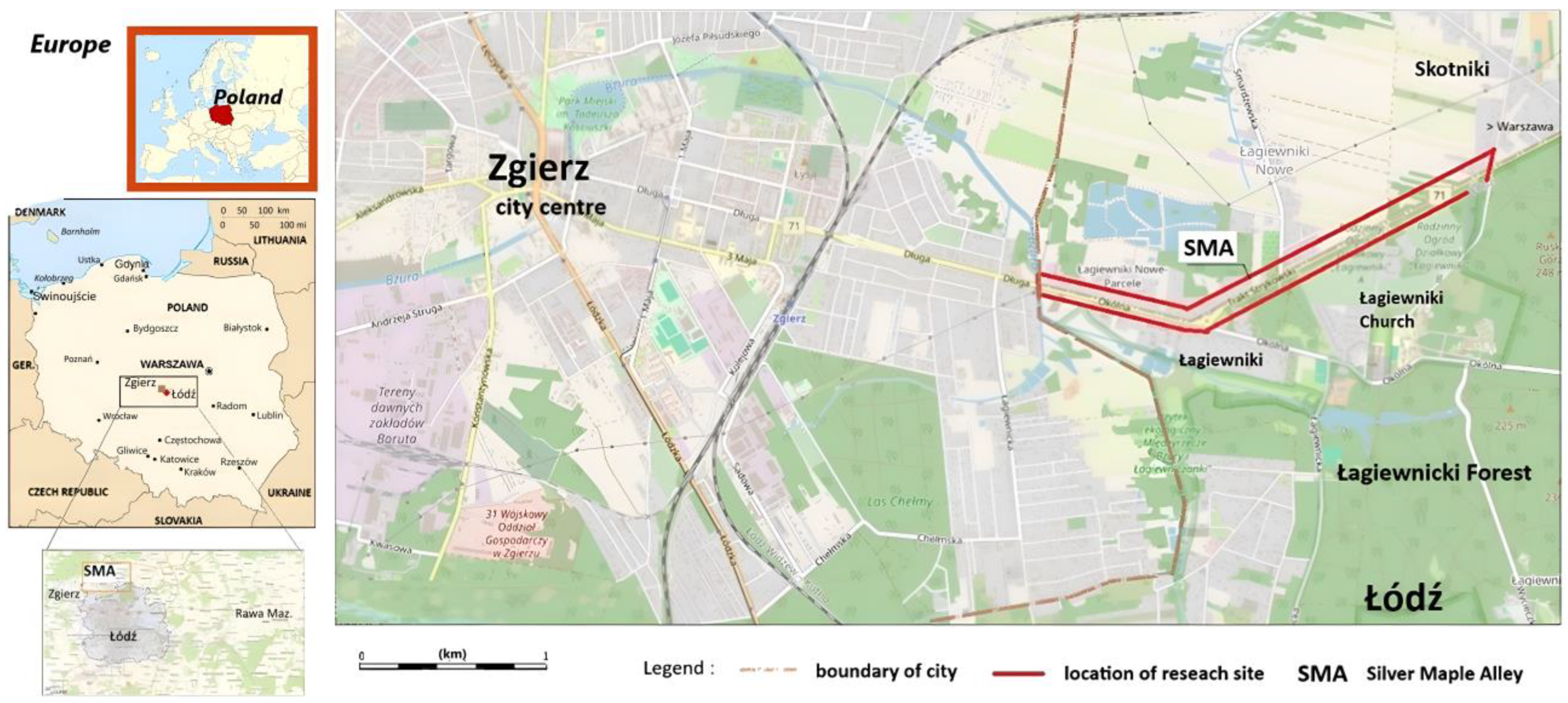

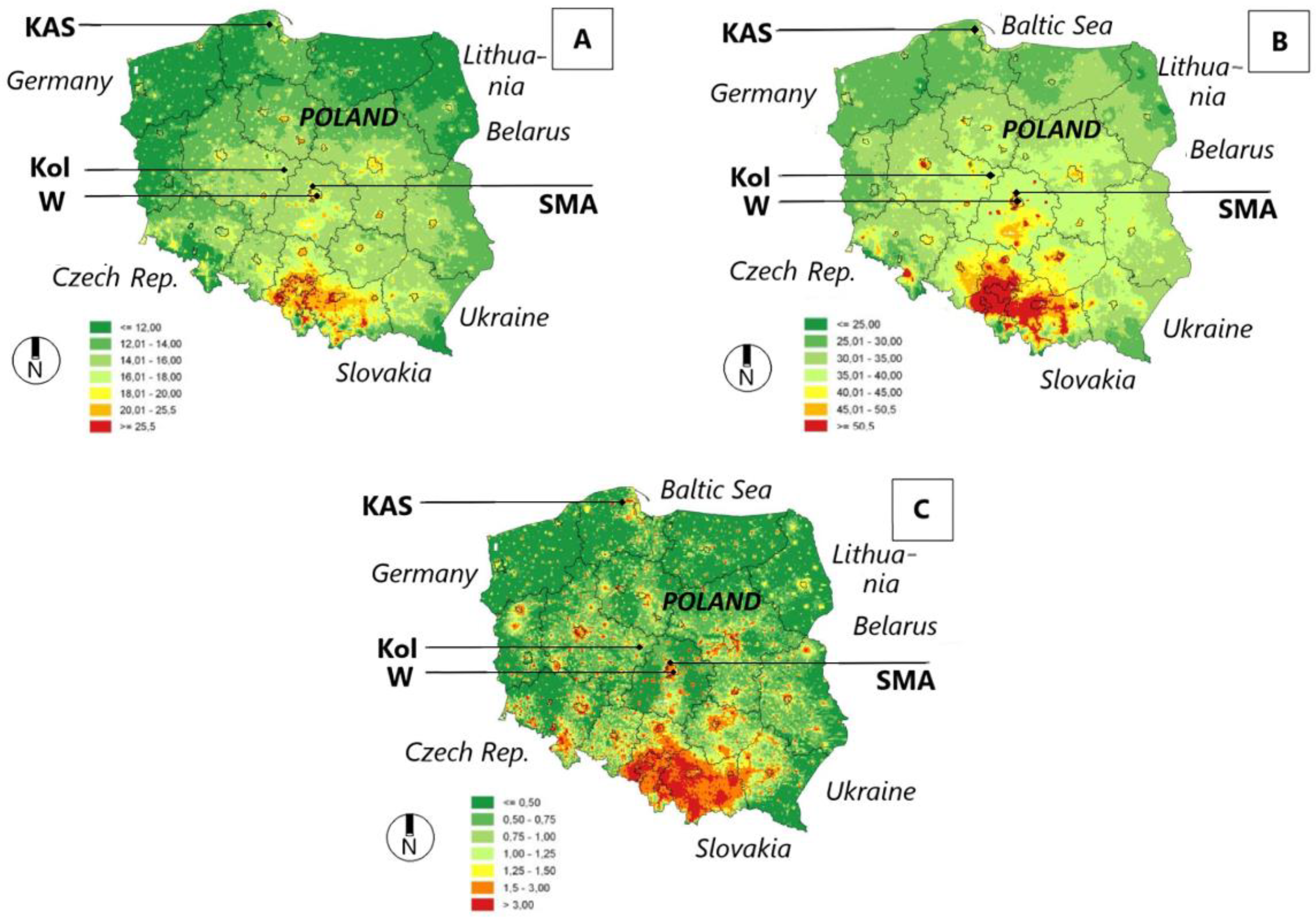
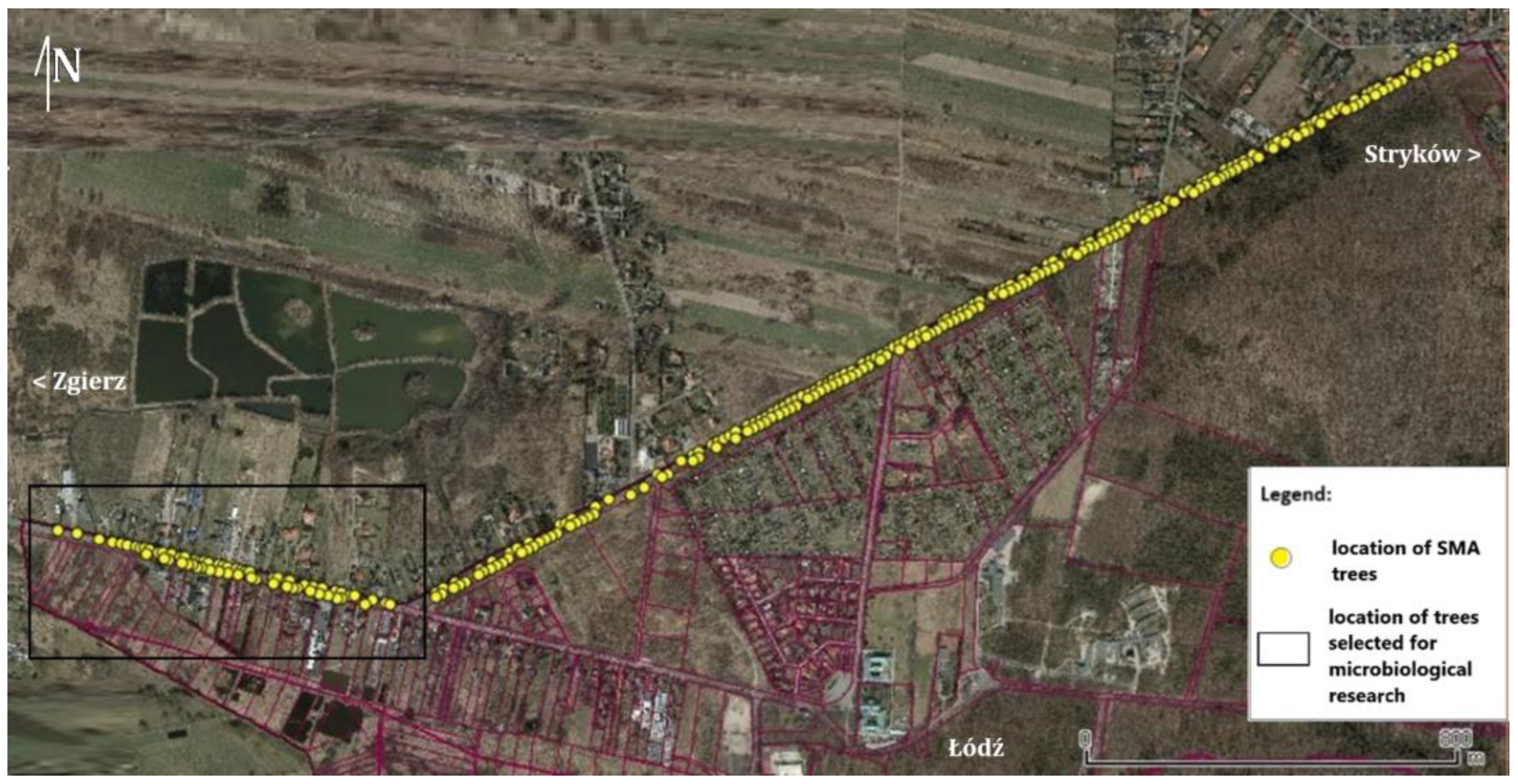

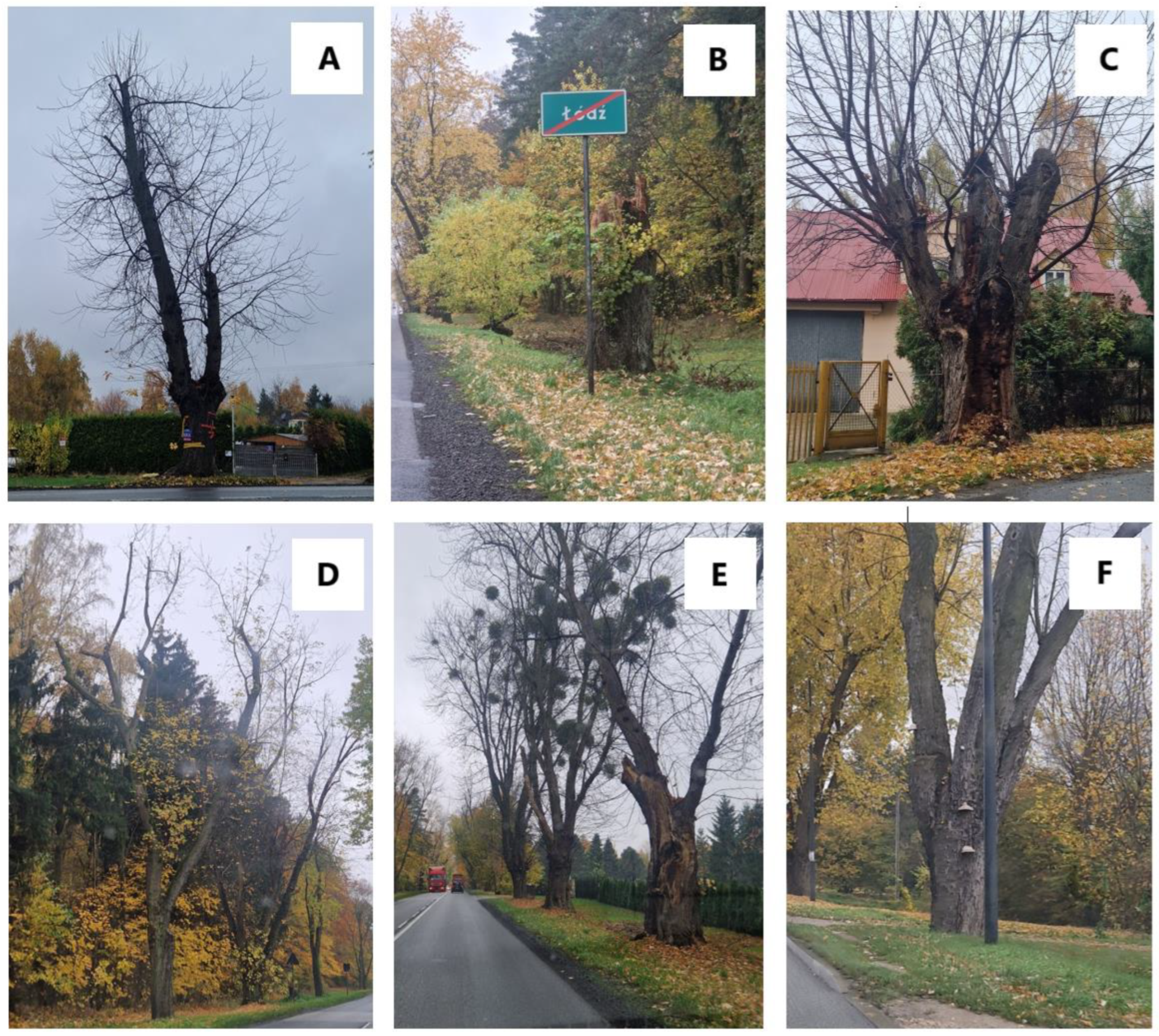
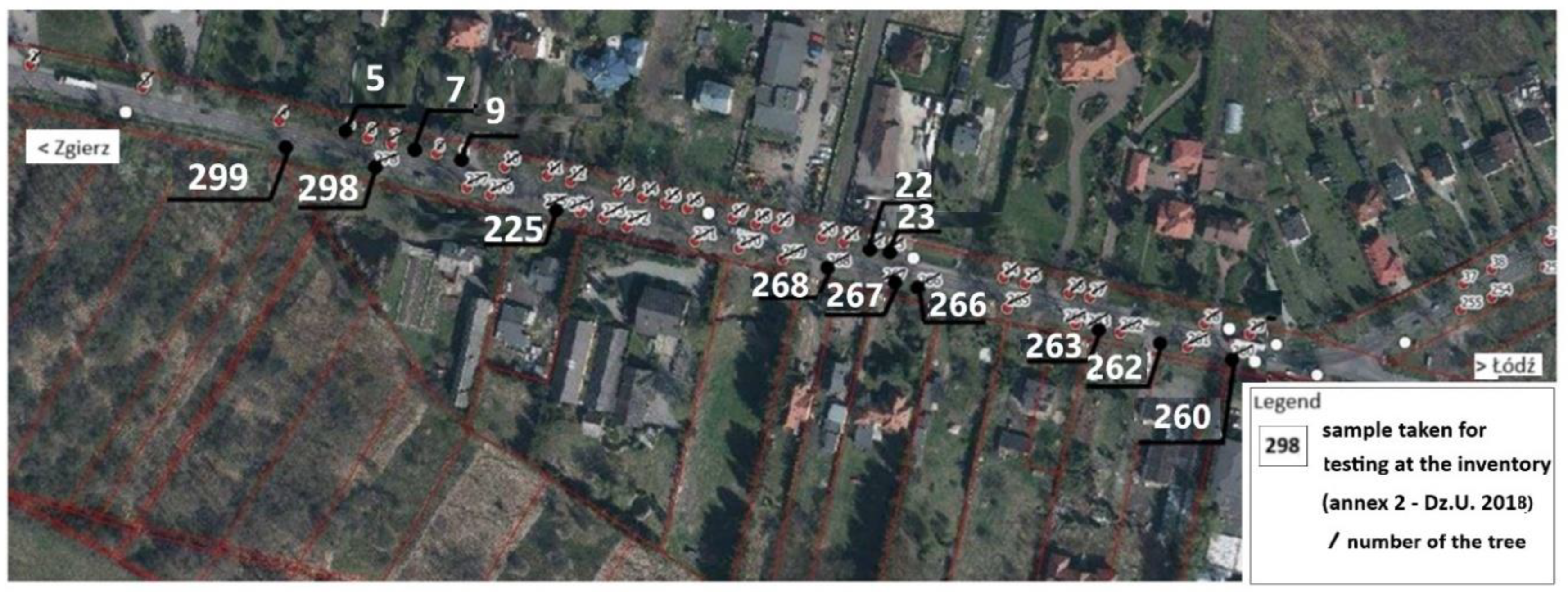
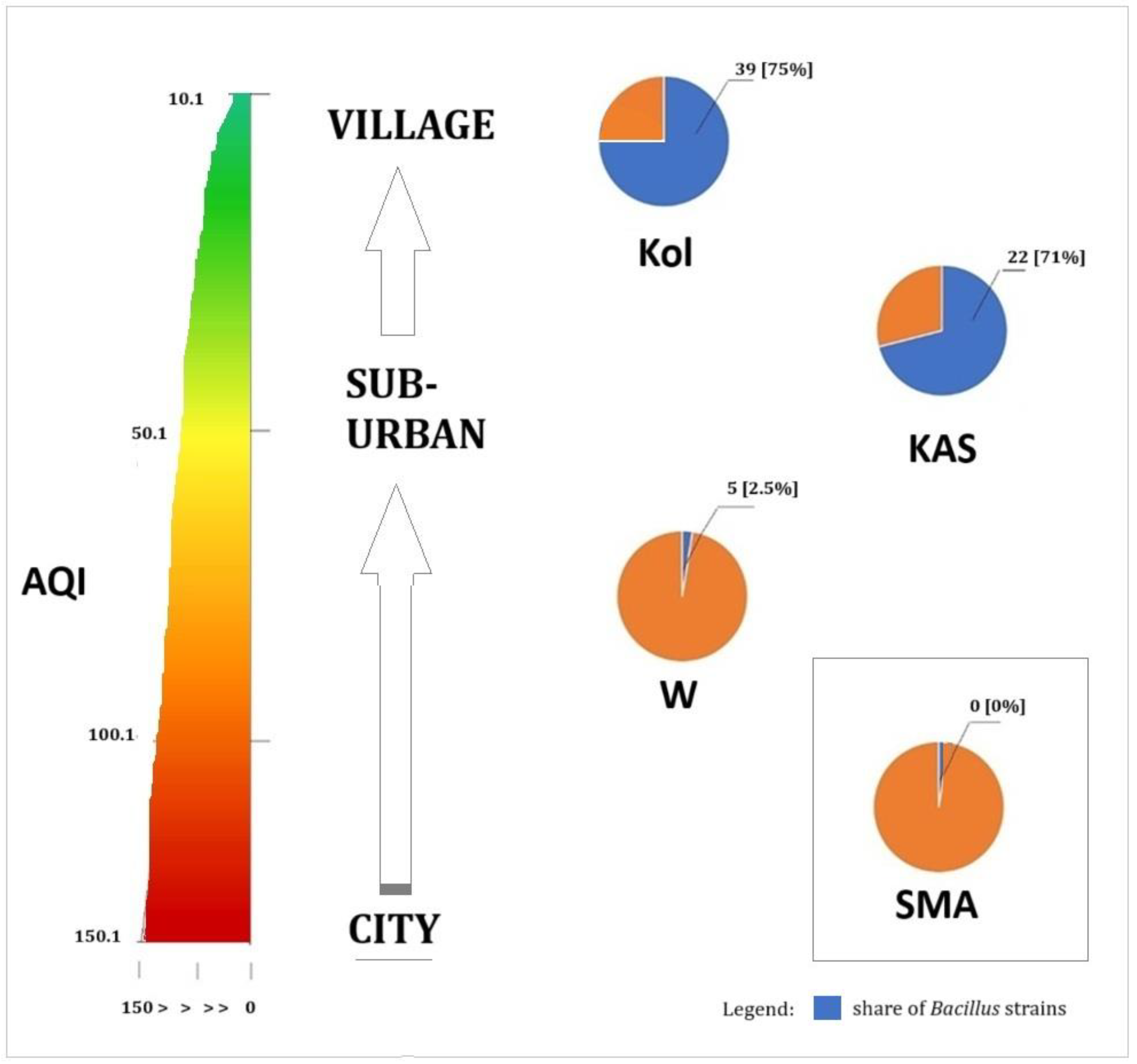
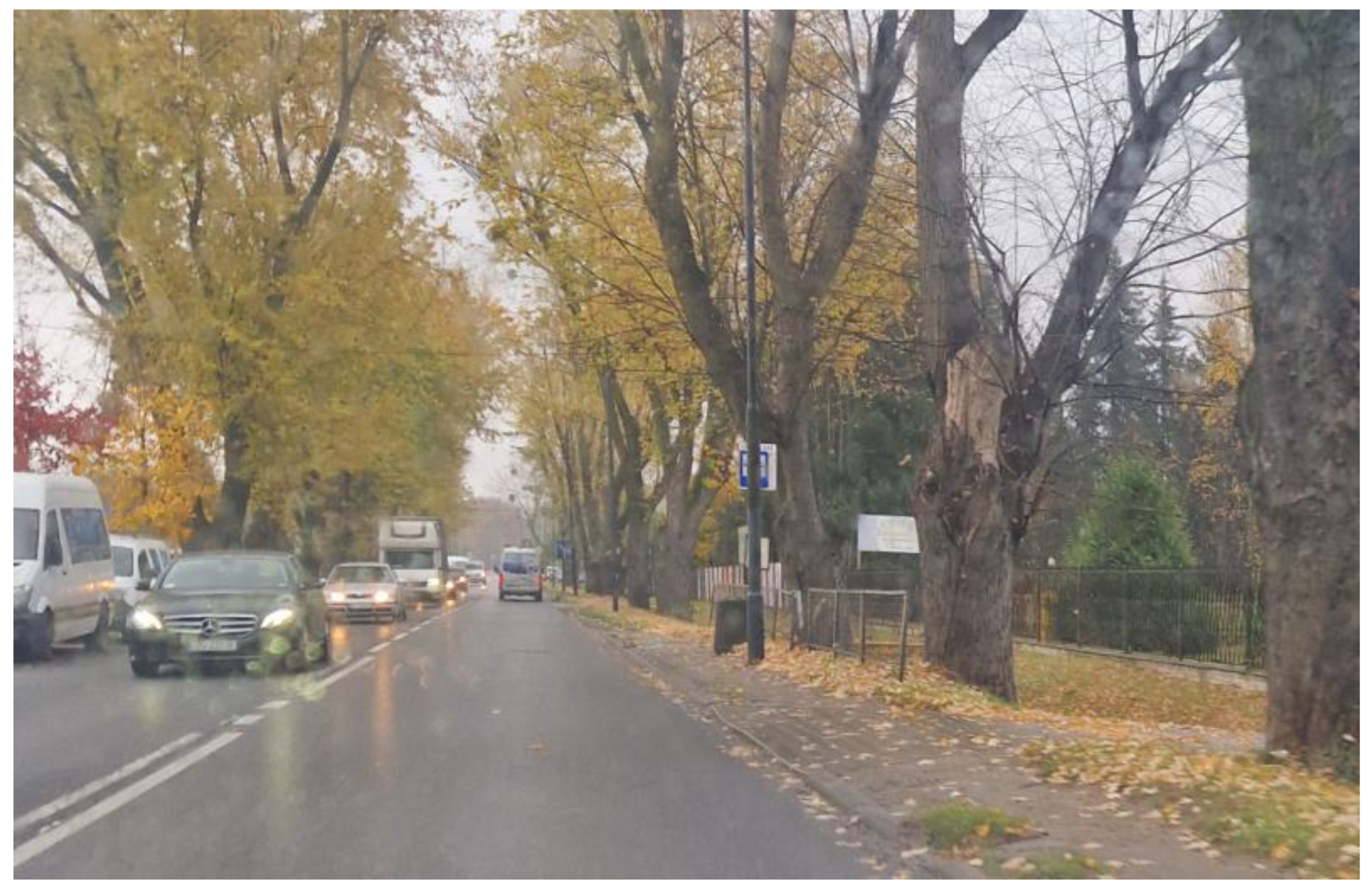
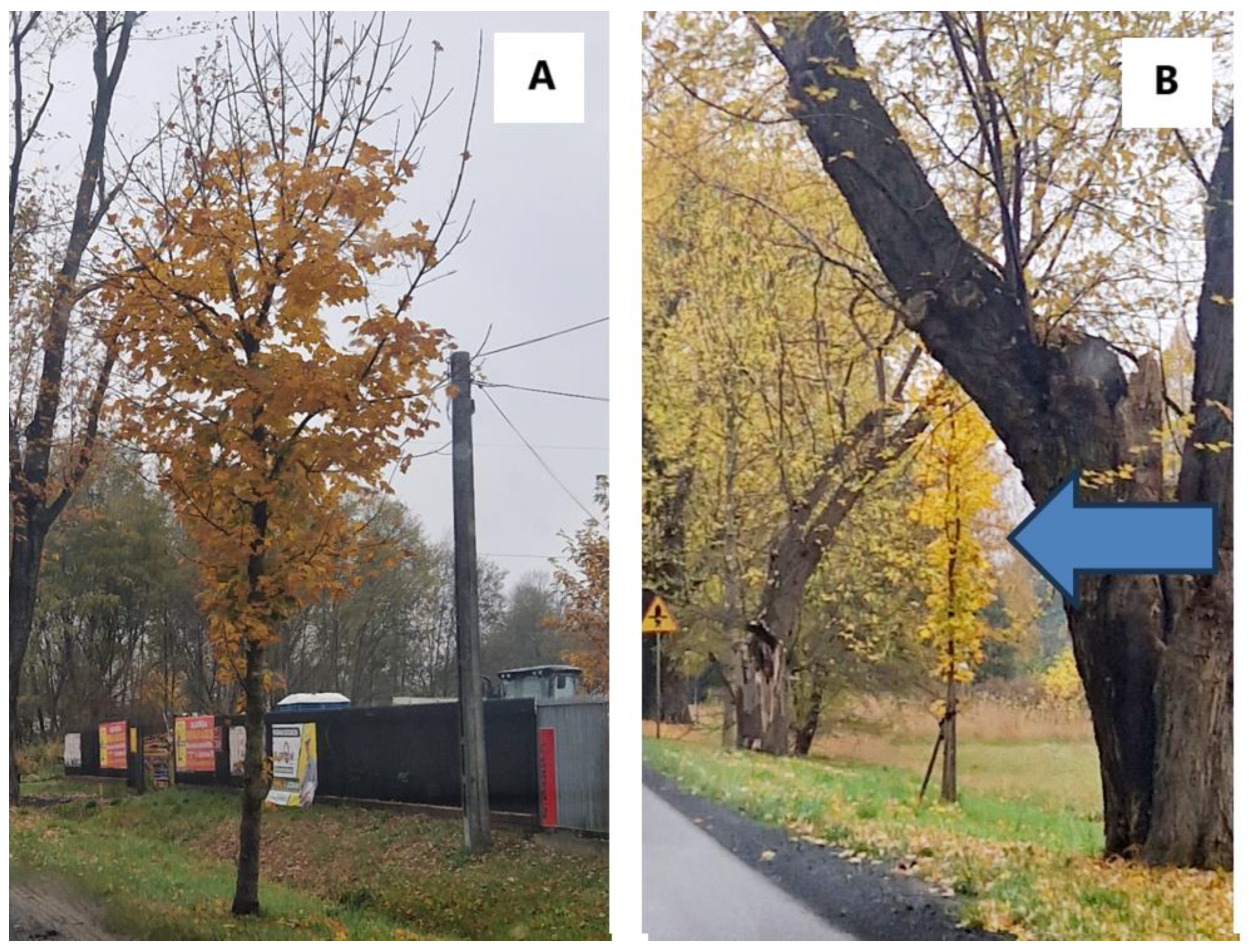
| Area of Soil Sample Collecting | nS | nHS | nHS/nS |
|---|---|---|---|
| Silver Maple Alley (SMA)—case study | 38 | 76 | 2.00 |
| Wiedźmin Square (W)—control test no. 1 | 32 | 40 | 1.25 |
| Kolnica (Kol)—control test no. 2 | 5 | 47 | 9.40 |
| Kashubian Landscape Park (KAS)—control test no. 3 | 4 | 31 | 7.75 |
| Assessing the strength of the relationship (linear correlation analysis) | r = 0.5731; p < 0.0001 | ||
| Estimated Parameter | Case Study SMA | Control Test No. 1 W | Control Test No. 2 Kol | Control Test No. 3 KAS |
|---|---|---|---|---|
| Number of soil samples | 38 | 32 | 5 | 4 |
| The number of bacteria in 1 g of soil | 1 × 104–1 × 108 | 1 × 105–3.6 × 107 | 2.4 × 109–4.8 × 1011 | 3.2 × 109–1.5 × 1012 |
| Soil pH range | 6.5–7.5 | 4.5–6.5 | 5.7–7.1 | 5.2–5.7 |
| AQI range 1 (Air Quality Index) | 101–150 | 51–100 | 0–50 | 0–50 |
| Number and percentage of Bacillus strains producing biosurfactants | 0 [0%] | 5 [2.5%] | 39 [75%] | 22 [71%] |
| PAHs content range [μg/g dry weight] | 0.05–2.7 | 26.39 | 0.04–0.19 | 0.03–0.24 |
Disclaimer/Publisher’s Note: The statements, opinions and data contained in all publications are solely those of the individual author(s) and contributor(s) and not of MDPI and/or the editor(s). MDPI and/or the editor(s) disclaim responsibility for any injury to people or property resulting from any ideas, methods, instructions or products referred to in the content. |
© 2025 by the authors. Licensee MDPI, Basel, Switzerland. This article is an open access article distributed under the terms and conditions of the Creative Commons Attribution (CC BY) license (https://creativecommons.org/licenses/by/4.0/).
Share and Cite
Długoński, A.; Łukaszkiewicz, J.; Fortuna-Antoszkiewicz, B.; Krych, J.; Bernat, P.; Paraszkiewicz, K.; Walaszczyk, A.; Marchewka, J. The Impact of Anthropopressure on the Health Condition of Ancient Roadside Trees for a Sustainable City: Example of the Silver Maples (Acer saccharinum L.) Alley in Łódź (Central Poland). Sustainability 2025, 17, 3724. https://doi.org/10.3390/su17083724
Długoński A, Łukaszkiewicz J, Fortuna-Antoszkiewicz B, Krych J, Bernat P, Paraszkiewicz K, Walaszczyk A, Marchewka J. The Impact of Anthropopressure on the Health Condition of Ancient Roadside Trees for a Sustainable City: Example of the Silver Maples (Acer saccharinum L.) Alley in Łódź (Central Poland). Sustainability. 2025; 17(8):3724. https://doi.org/10.3390/su17083724
Chicago/Turabian StyleDługoński, Andrzej, Jan Łukaszkiewicz, Beata Fortuna-Antoszkiewicz, Jacek Krych, Przemysław Bernat, Katarzyna Paraszkiewicz, Aleksandra Walaszczyk, and Justyna Marchewka. 2025. "The Impact of Anthropopressure on the Health Condition of Ancient Roadside Trees for a Sustainable City: Example of the Silver Maples (Acer saccharinum L.) Alley in Łódź (Central Poland)" Sustainability 17, no. 8: 3724. https://doi.org/10.3390/su17083724
APA StyleDługoński, A., Łukaszkiewicz, J., Fortuna-Antoszkiewicz, B., Krych, J., Bernat, P., Paraszkiewicz, K., Walaszczyk, A., & Marchewka, J. (2025). The Impact of Anthropopressure on the Health Condition of Ancient Roadside Trees for a Sustainable City: Example of the Silver Maples (Acer saccharinum L.) Alley in Łódź (Central Poland). Sustainability, 17(8), 3724. https://doi.org/10.3390/su17083724






